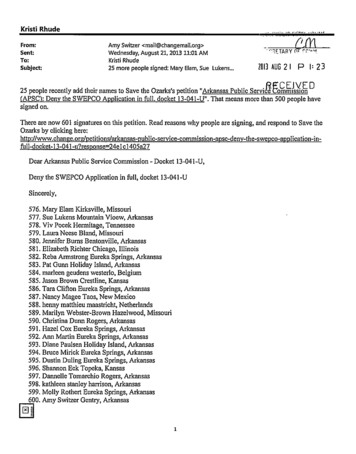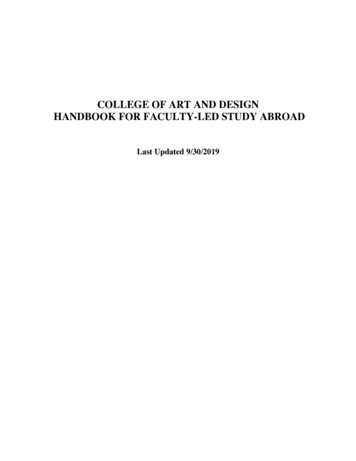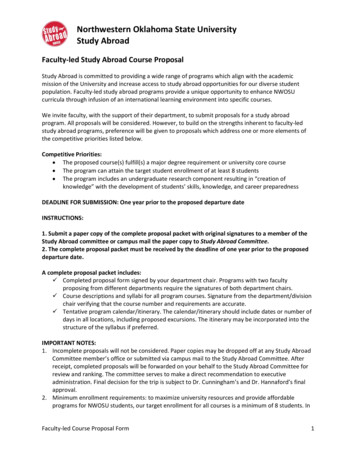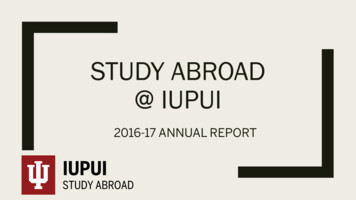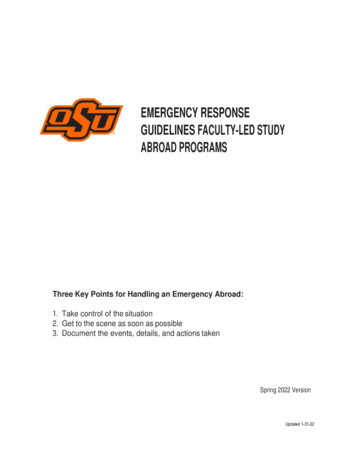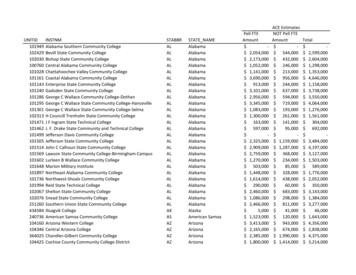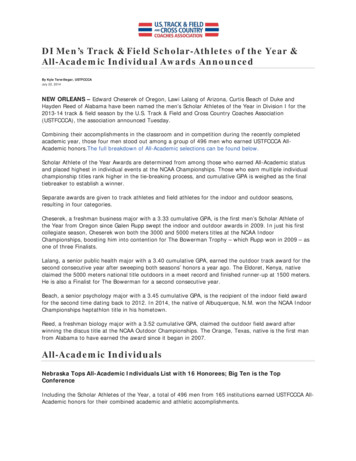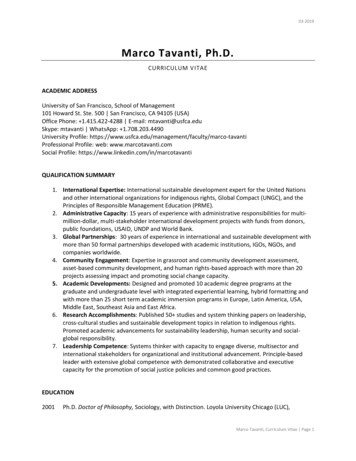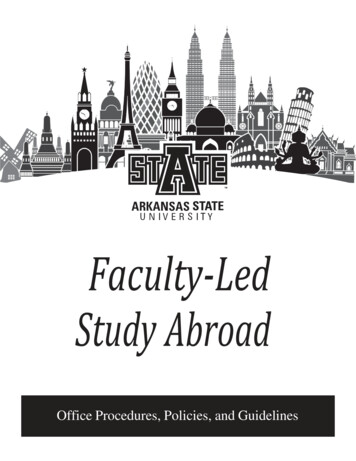
Transcription
Faculty-LedStudy AbroadOffice Procedures, Policies, and Guidelines
Faculty-Led Study AbroadOffice Procedures, Policies, and GuidelinesArkansas State UniversityEffective: July 1, 2018TABLE OF CONTENTSINTRODUCTION. . 3GUIDELINES FOR FACULTY-LED STUDY ABROAD PROGRAMS . 3FACULTY-LED STUDY ABROAD PROGRAM PROPSAOL . 3Proposal Review and Selection. .4ACADEMIC REQUIREMENTS. 4Credit/Contact Hours . 4Learning Objectives . 5PROGRAM MODELS . 5FACULTY LEADERS/FACULTY ASSISTANTS .6Participant Numbers . 6PLANNING THE STUDY ABROAD PROGRAM . 6FACULTY LEADER RESPONSIBILITIES . 6Program Design. . 6Recruiting. 7Program Cost to the Student. 7Pre-Departure Planning. 8What to Discuss During Pre-Departure Orientation Meetings . 8Setting Academic and Behavioral Expectations for the Group . 8While Abroad. 9Upon Return . 9ACADEMIC AND OTHER STUDENT ACCOMMODATIONS . 9HEALTH AND SAFETY ISSUES . 11FACULTY-LEADER ROLE IN THE STUDENT APPLICATION AND ADMISSIONSPROCESS . 11STUDENT APPLICATIONS . 11Pre-Acceptance . 11Post-Acceptance . 11Study Abroad Admission Criteria . 12REGISTRATION . 12FINANCIAL AID AND SCHOLARSHIPS FOR FACULTY-LED STUDY ABROADPROGRAMS . 13GUIDELINES FOR ACCOMPANYING FAMILY MEMBERS . 13POST-PROGRAM ACTIVITIES . 13SAO ADMINISTRATIVE SERVICES. 14
Program Design Assistance. 14Recruiting Assistance . 14Admissions Process . 15Pre-Departure Planning Assistance . 15While Abroad . 15Upon Return . 15
IntroductionThe Study Abroad Office (SAO) at Arkansas State University believes a student’s Study Abroad experience can be one of the most enriching and motivating experiences of his or her life. The SAO is pleased thatfaculty have decided to join students on this journey. Leading an A-State Faculty-Led Study Abroad programwill provide the opportunity to reach students in ways not always possible at A-State. Faculty will be spendingmuch more time with students, both inside and outside of class, and will likely serve as an advisor and mentor.By sharing this experience abroad with students, faculty will have an opportunity to shape perspectives andbroaden minds. The effect faculty will have on students will last throughout their lifetime.The SAO is charged with the administration of all programs abroad offered to A-State students. Any facultymember who wishes to direct a Study Abroad program overseas must work through the SAO.The Study Abroad Office also provides orientation workshops for students going abroad, and a network of support services for A-State students while overseas.The purpose of the Faculty Guide is to inform Faculty Leaders and Faculty Assistants who will accompanyand teach students abroad. It is designed to provide faculty with general assistance as they propose, develop,and lead an A-State short-term Study Abroad program. In this guide, faculty will find information outlining theresponsibilities of both the Faculty Leader and the SAO, travel guidelines, and other important topics.Guidelines for Faculty-Led Study Abroad ProgramsFaculty-Led Study Abroad is a group experience involving significant travel to a location outside of theUnited States and U.S. territories. Such experiences may constitute the whole or part of a course. Study Abroadis a University-sanctioned activity and requires completion of the A-State Study Abroad forms and proceduresas outlined in this guide.The following guidelines apply to all A-State Faculty-Led Study Abroad programs. These guidelines and procedures are designed to ensure academic integrity and diligence in developing all Study Abroad courses. A StudyAbroad program will not have the approval of the University unless all procedures have been followed and theresponsible faculty member has been informed that the proposed program has been approved by the SAO.Faculty-Led Study Abroad Program ProposalAll Faculty-Led programs are administered by the SAO in partnership with A-State academic departments. Any faculty member who seeks to lead a program overseas must submit a proposal, be approved by theSAO, and adhere to the policies and procedures regarding Faculty-Led programs.The academic department and college are responsible for reviewing and endorsing all academic components ofthe proposed program including course subject matter, instructional methods, syllabus(I), and contact hour requirements (see Credit/contact hours section below) prior to submission to the SAO. Department Chair/CollegeDean Proposal Review Guidelines have been developed by the SAO to assist in this task.Due to the critical role the Faculty Leader plays in recruitment for the program, faculty who will be absent fromcampus (sabbatical, extended leave, etc.) for any part of the academic year prior to the proposed program maynot be eligible to apply. If faculty anticipate taking any scheduled leave, please contact the SAO for more information prior to submitting a proposal.Multiple proposals can be submitted by faculty members within the same department and/or college if not beingran in the same session and location. However,
student demand will be taken into account when selecting programs for each cycle. Department chairs and/orcollege deans are encouraged to consult with the SAO in advance of the deadline if multiple proposals are beingsubmitted.Interdisciplinary programs are encouraged as they increase the learning outcomes for the students and the marketability of the program. Please note that if multiple departments are included in a proposal, each departmentchair and corresponding college dean must sign off on the proposal.Sample course syllabi, program itineraries, and Contact Hour Calculation Sheets are available online to assistfaculty in the proposal process. All necessary forms are available for review on the Faculty & Staff Resourcespage. Reviewing these documents prior to submitting the proposal should address some basic questions andprovide examples of successful past proposals.Proposal review and selection. All proposals are reviewed by the SAO. Please refer to Faculty-LedProgram Proposal Review Considerations for information on how proposals are reviewed and selected. Facultymembers will be notified within one week of the submission deadline regarding the outcome of their proposal.Once the program is approved, the Faculty Leader should work with the SAO and academic department if subsequent modifications to the program are needed. Any modifications to the academic content, course offerings,number of contact hours/credits, Faculty Leader/Faculty Assistant, program dates, program length, housing,and/or cultural activities must be made in consultation with the academic department and college. Any costsincurred from flight changes made by a Faculty Leader/Faculty Assistant will be his/her responsibility.Academic Requirements Syllabi for all courses associated with the Study Abroad program must be submitted as part of theprogram proposal.Syllabi should include a timeline or tentative program schedule, learning and cultural activities, andstudent learning outcomes.Credit/contact hours. A Faculty-Led Study Abroad program should be referred to as a program and nota trip. A-State courses offered abroad must be of comparable academic rigor to those offered on campus. Thenumber of credits associated with the program should be based on 45 contact hours for three (3) A-State credits.As part of the faculty led proposal packet, the faculty member will need to provide the itinerary that shows their45 contact hours will be met. The Program Contact Hours Calculation Sheet submitted as part of the proposalserves as documentation of the contact hours involved. An example of the Program Contact Hours CalculationSheet can be provided upon request.Contact hours may include classroom time, lectures, field trips/excursions, group learning activities, programspecific orientation meetings, research, service-learning, community projects, volunteer time, homework/assignments, other academic activities, and cultural activities conducted prior to, during, and/or after the in-countryprogram dates.Learning objectives. Courses associated with Faculty-Led programs must meet the learning objectivesindicated in the approved syllabus. Adaptations to the course outline, learning activities, and assignments maybe made with the approval of the department chair and college dean to reflect the international context in whichit will be taught and to ensure the content is applicable to the host country/region. The proposal should indicatehow the proposed learning activities meet the course objectives.Program Models
Faculty-Led Study Abroad programs vary widely in terms of program itineraries, academic focus, dura-
tion, inclusions, and scope. The program might be a course taught almost entirely abroad with a small numberof meetings or assignments prior to departure or upon return. It might feature a short overseas component embedded in a larger course taught on the A-State campus during the regular term. Or, it might be designed using ahybrid model with some class meetings taking place on the A-State campus leading up to a mid-length abroadportion.Academic delivery can also take on many forms including: faculty members teaching in a classroom space and/or on-site (museum, cultural locale); lectures by guest speakers and local experts; classes taught by faculty notemployed by A-State (language institute or host institution); service-learning components integrating community service with guided instruction and reflection by the faculty member or contracted local instructor; researchcomponents or projects; third-party vendors, and language acquisition.Logistics for the program will be arranged by the on-site provider contracted by the SAO in collaboration withthe Faculty Leader. The group may stay in one location for the duration of the program, possibly with day orweekend trips further afield, or travel within one or more cities or countries. Accommodations might includehotels, youth hostels, apartments, university housing, host families, or even camping. Most programs includeonly group welcome and farewell dinners, but others may include most or all meals depending on the location.In-country transportation options range from public (metro, bus, train) to walking. Programs typically includeairport pick-up and drop-off.The courses associated with the program can range from existing A-State courses with student learning goalsand assignments adjusted to reflect and incorporate location (these could be specific courses, special topics, ortravel study designations) to the development of new courses approved through University curriculum committees. Courses offered abroad must be of comparable academic rigor to those offered on-campus.Leading a Study Abroad program allows faculty to explore alternate teaching pedagogies and practices offeringopportunities to think outside of the box.Faculty Leaders/Faculty AssistantsA program has one primary Faculty Leader. This individual is responsible for teaching the course andwill receive his/her regular compensation and travel expenses.An A-State Faculty Assistant who is qualified to teach the course may accompany the Faculty Leader in a supportive role, if the program enrollment and budget allows. A rationale must be included in the program proposalfor the addition of a Faculty Assistant. The Faculty Assistant will assume teaching duties without extra compensation; however, his/her program expenses will be covered.Participant numbers. Target minimum and maximum enrollment numbers will be determined duringthe program development phase.Planning the Study Abroad ProgramWhen the Study Abroad academic program proposal is approved, the study abroad office will schedulea meeting with the Faculty-Leader to discuss the planning and implementation of the program. Programplanning takes place during the summer prior to the year the program occurs.By agreeing to direct a program abroad, faculty will have the opportunity to enjoy many of the benefits of over-
seas travel, but along with these benefits are responsibilities that are not usually a part of regular teaching dutieson campus. The following highlights the responsibilities of the Faculty Leader of a short-term Study Abroadprogram, as well as the administrative services the SAO provides to support these efforts.Faculty Leader ResponsibilitiesProgram design. The following steps are recommended for program design planning:1) Identify appropriate course and corresponding number of credits with the academic department and college;2) Determine admissions criteria in consultation with the SAO; 3) Work with the SAO to determine host institution/provider abroad and provide the SAO with contacts (if any); and 4) Work with the SAO to determineprogram excursions and field trips, including possible experiential learning opportunities.Recruiting. Recruiting students for the program is one of the primary responsibilities of the FacultyLeader. The Faculty Leader is the main motivation of the students to go abroad. A minimum target number ofstudents (per the program budget) should be enrolled in the course. TheStudy Abroad staff, in collaboration withStudy Abroad Ambassadors, will assist the Faculty Leader with re-cruitment efforts for all A-State Study Abroadprograms. These efforts include the following: Recruit A-State students on-campus through in-class presentations and information sessions.Recruit A-State students off-campus through contacts with other institutions or organizations.Utilize marketing materials created by the SAO and refer students to the Study Abroad Faculty-LedPrograms webpage.Communicate with prospective and admitted students leading up to the program.Respond to admissions-related requests in a timely fashion.Program cost to the student. The Faculty Leader must communicate clearly with students about theprogram costs, including what is covered and any additional expenses that are not covered in the program. Forexample, students must understand the cost of required immunizations, medical insurance and immunizations,visa, meals, and personal money to be used for souvenirs/activities. The Faculty Leader should only advertiseplanned activities that can be covered within the budget based on the minimum number of students. The FacultyLeader should share with students broad budget categories such as airfare, housing, meals, transportation, andentrance fees (if applicable). Any costs incurred from flight changes made by a student will be his/her responsibility.Students must pay all fees for the program directly to the A-State Student Accounts Office as directed in the program application. Program deposits must be submitted as directed at the time of application. Faculty memberscannot collect fees from students.Pre-departure planning. Provide the SAO with any course-specific pre-departure materials to be shared with the students. Work with the SAO to finalize the program itinerary and budget, and to sign the program contract forthe third-party or service provider by the end of June of the year prior to the program. Create the course in Banner in conjunction with the academic department. Utilize marketing materials created by the SAO and refer students to the Study Abroad Faculty-LedPrograms webpage. Complete the A-State Travel Authorization (and advance request if desired), submit the A-State Export Control Form, and complete the Faculty Contract prepared by the SAO. Submit the A-State Faculty-Led Study Abroad Program Proposal to the SAO by May 1 of the yearprior to the program. Secure proposal approval by the department chair and submit to the college dean for review at leasttwo weeks prior to the submission deadline.
Prepare students for the cultural experience in the host country. Read and be familiar with the contents of the Faculty-Led Study Abroad Guide and participate in Faculty Leader training (required forfirst time Faculty Leaders/Faculty Assistants) arranged by the SAO.Participate in pre-departure orientation meeting for faculty members arranged by the SAO at thepredetermined date, time and location. This orientation will be conducted to address the facultymembers’ responsibilities, safety, health and other essential subject matters.Participate in the pre-departure student orientation arranged by the SAO at the predetermined date,time, and location.Make arrangements for in-country or on-site accommodations prior to departure if requested bystudents (see Academic and Other Accommodations section below) in consultation with Accessand Accommodation Services and the SAO.What to discuss during pre-departure orientation meetings. Program orientation begins when students first see a program flyer or when they visit the program page, and continues throughout the pre-departureprocess. Because of this, and because oral presentations can constitute a contractual agreement, all informationabout the program needs to be clear, consistent, and accurate. A 45-minute pre-departure orientation meetingwill be held in conjunction with the SAO after the students for the program have been selected. The date, time,and location will be determined in advance by the SAO in collaboration with the Faculty Leader.The SAO will cover general logistical and administrative topics such as billing, registration, health insurance,money, general health and safety abroad, travel documentation, travel arrangements, modes forcommunication, and cultural adjustment considerations. As for the mode of communication to use while the group isin the country, our office encourages the faculty member to create a group chat within the mobile app, Whatsapp. It isencouraged by the SAO that the Faculty Leader creates the Whatsapp group before the trip with all students. This app isnot to be used in emergencies but rather for communication purposes for the group in the host country. To be in contactduring an emergency or to update the SAO on more serious matters, use the messaging system within the KeyNect Upsoftware that you reviewed during orientation or dial the emergency number: (001) 870-680-2535. The Faculty Leadershould be prepared to discuss program specificdetails with the group including: the course syllabus andassignments; academic and behavioral expectations; program itinerary; packing (what to bring and what not tobring); and potential health and safety risks in the host country.The SAO will provide each student with an electronic Study Abroad orientation packet which contains generalinformation. The Faculty Leader should provide any additional materials to the SAO in advance to be includedin the orientation packet.The SAO recommends that the Faculty Leader hold additional group meetings with students prior to departure.This will allow for the students to get to know each other and will provide more time to discuss expectationsand motivations for participating in the program.Setting academic and behavioral expectations for the group. During Faculty-Led Study Abroad programs, students are required to attend all classes and excursions which are a part of the program itinerary. Theonly acceptable excuse for missing a class or an excursion is illness. Attendance policies apply to all classes andactivities while abroad.Students are expected to serve as ambassadors for both A-State and the United States. Since it is often difficultfor students to understand the scope of what is expected of them in this regard, it is important for the FacultyLeader to discuss the topics below in pre-departure meetings and again upon arrival. Students need to be awarethat behaviors with minimal or no consequences at A-State may have major implications during the StudyAbroad program. Students are bound by the A-State Student Code of Conduct while overseas and any breach ofconduct may result in actions being taken upon return to campus.
These topics should be discussed repeatedly with students, including at any pre-departure orientation meetingsand again after arrival in the host country. Topics should include: Appropriate dressLocal laws and customsU.S. Customs and Border Protection Declaration FormLocal safety
Gender dynamicsYouth/elder relationshipsFood and meal etiquetteHow to recognize signs of displeasure on the part of host country nationalsSafe behaviorIncident reportingAlcohol use/abuseWhile abroad. Provide an initial on-site orientation to introduce students to the host site and culture (may be in conjunction with an on-site program organizer). Contact the SAO by email or phone within the first 12 hours after arrival to confirm all students aresafe and accounted for. Notify the SAO immediately if any student leaves the program. Be responsible for the academic integrity of the course and for coordinating class activities. Accompany students and participate in all scheduled items on the itinerary, from point of departureto point of return. Coordinate with any overseas faculty/lecturers. Act as the Resident Director in charge of the overall well-being of students. Resolve any housing or other issues that may arise on-site. Supervise excursions and coordinate with on-site staff, if applicable. Schedule regular office hours and meeting times with students. Alert the SAO immediately of any problems so issues can be resolved in a timely manner. Facilitate intercultural learning and reflection while on-site and evaluate student assignments. Communicate with the SAO regarding any incidents or necessary changes to the program. Cooperate with other on-site faculty members regarding the program objectives. Act as liaison between the students and any individuals or entities providing services for the program. Ensure the on-site cooperating institution/organization is delivering services according to the contract provided to the Faculty Leader by the SAO prior to departure. If problems arise, the FacultyLeader should alert the SAO immediately so any discrepancies can be resolved in a timely manner. Enforce policy stating non-A-State students are not allowed to accompany the participating studentson program-sponsored excursions or activities. Communicate academic and disciplinary roles clearly to the students. Respond to any emergency situations or serious incidents which may arise (illness, accident, crimeinvolving a student, severe behavioral issues, natural disaster, political uprising) and notify the SAOeams seorgoennacsieps)o.ssible by email, text, or phone (see Safety, Emergency, and Discipline Guide for Itemize usage of any fund advances and other necessary expenses and collect receipts to be submitted for reconciliation upon return to the U.S. Never loan program or personal funds to studentsunless it is an extreme emergency. The Faculty Leader will not be reimbursed by the University forloaning money to students unless authorized in advance by the SAO.Meet with students regularly throughout the program to discuss non-academic issues. Topics for discussion mayinclude cross-cultural adjustment, personal activities, and inappropriate behavior. These sessions build groupcohesiveness and alleviate possible divisions.Be aware of possible indicators of culture shock. These can include: feelings of helplessness; loneliness; alienation; sleeping more than usual; depression; getting angry easily; decline in flexibility; stereotyping of the hostculture; increase in physical ailments; eating problems; inability to concentrate; and uncontrollable crying.Many students, though not all, experience some level of culture shock. The concrete indicators of culture shock
vary greatly from individual to individual. Closely monitor changes in behavior and report any significant concerns to the SAO.Upon return. Submit grades within 30 days of the conclusion of the program, or at the end of the term, whicheveroccurs later. Complete program expense reconciliation within one week of the program return date. Submit a written report of the program to the SAO within 30 days of return.Academic and Other Student AccommodationsStudents are asked to self-disclose any disability (chronic medical or psychological condition, learningdisability, ADHD, an autism spectrum disorder, or a mobility, vision or hearing disability) to the SAO as earlyas possible after admission to the program. The SAO will share this information with the Faculty Leader, unlessdissemination is not allowable under HIPPA regulations.If a student approaches the Faculty Leader to discuss special needs or particular accommodations related to theirStudy Abroad program, please notify the SAO.To request accommodations for a Study Abroad program, students must obtain an Accommodation Card fortheir specific term abroad from Access and Accommodation Services and submit a copy to the SAO.Appropriate ar- rangements will be made to the extent possible including, but not limited to, housing,transportation, field trips,excursions, cultural activities, and classroom or test accommodations. If a studentdoes not provide an Accom- modation Card, accommodations cannot be provided on the basis of a disability.Arrangements for most academic accommodations (note taking services, recording devices, smart pens, extended testing time) are typically made by the Faculty Leader just as if he/she were teaching a course on campus.If special circumstances unique to the Study Abroad program make providing these accommodations difficult,please contact the SAO. Accommodations pertaining to non-academic components of the program (housing,transportation, additional on-site support) will be assessed and organized by the SAO in consultation with Disability Services, the student, the Faculty Leader, and the on-site provider.Information related to a student’s disability is confidential and protected under HIPAA. The student should beafforded the opportunity to meet with the Faculty Leader and/or the SAO privately to discuss disability-relatedmatters.For more information, please see the Faculty Guide for Teaching and Accommodating Students with Disabilities.Health and Safety IssuesTo support a healthy and safe experience, A-State provides a comprehensive Study Abroad health insurance and travel assistance plan for all students and faculty participating in A-State Study Abroad programs. Allstudents in A-State programs are required to enroll in the Study Abroad health insurance plan for the period oftime they are abroad. The cost is to be included in the program fee. Faculty who l
Faculty-Led Study Abroad is a group experience involving significant travel to a location outside of the United States and U.S. territories. Such experiences may constitute the whole or part of a course. Study Abroad is a University-sanctioned activity and requires completion of the A-State Study Abroad forms and procedures as outlined in this .

